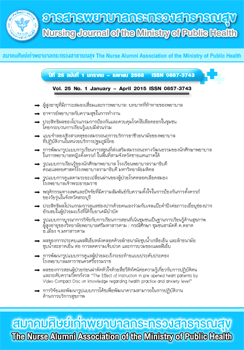รูปแบบการดูแลตามระยะเปลี่ยนผ่านของผู้ป่วยโรคหลอดเลือดสมอง โรงพยาบาลเจ้าพระยายมราช,A Transitional Care Model for Stroke Patients at Chaopraya Yommarat Hospital.
Main Article Content
Abstract
รูปแบบการดูแลตามระยะเปลี่ยนผ่านของผู้ป่วยโรคหลอดเลือดสมอง
โรงพยาบาลเจ้าพระยายมราช
ปราณี เกษรสันติ์ *
บทคัดย่อ
การวิจัยนี้เป็นการวิจัยกึ่งทดลอง มีวัตถุประสงค์ เพื่อศึกษาผลของรูปแบบการดูแลการดูแลตามระยะเปลี่ยนผ่านของผู้ป่วยโรคหลอดเลือดสมอง แบ่งเป็น 2 ระยะ คือขณะอยู่โรงพยาบาลและหลังจำหน่าย 6 สัปดาห์ โรงพยาบาลเจ้าพระยายมราช กลุ่มตัวอย่างมีจำนวน 60 คนเลือกกลุ่มตัวอย่างแบบสุ่มเจาะจง แบ่งเป็นกลุ่มทดลองจำนวน 30 คน และกลุ่มควบคุม 30 ราย รูปแบบการดูแลตามระยะเปลี่ยนผ่านของผู้ป่วยโรคหลอดเลือดสมอง ประกอบด้วย รูปแบบการดูแลตามระยะเปลี่ยนผ่านของผู้ป่วยโรคหลอดเลือดสมอง คู่มือการปฏิบัติกิจวัตรประจำวันและคู่มือการดูแลผู้ป่วยโรคหลอดเลือดสมอง เครื่องมือที่ใช้ในการเก็บรวบรวมข้อมูลมี 3 ชุด คือ แบบบันทึกข้อมูลส่วนบุคคลของผู้ป่วย แบบประเมินความสามารถในการปฏิบัติกิจวัตรประจำวันของผู้ป่วยโรคหลอดเลือดสมอง แบบวัดความรู้ของผู้ป่วยเกี่ยวกับโรคหลอดเลือดสมอง และแบบประเมินระดับความพึงพอใจของผู้ป่วยโรคหลอดเลือดสมอง วิเคราะห์ข้อมูลด้วย ร้อยละ ค่าเฉลี่ย ค่าเบี่ยงเบนมาตรฐาน การทดสอบที (t-test)
ผลการวิจัย พบว่า ค่าเฉลี่ยคะแนนความสามารถในการปฏิบัติกิจวัตรประจำวันของผู้ป่วยโรคหลอดเลือดสมองกลุ่มทดลองภายหลังได้รับการดูแลตามระยะเปลี่ยนผ่านสูงกว่ากลุ่มควบคุม อย่างมีนัยสำคัญทางสถิติที่ระดับ .05 ในด้านความรู้ของผู้ป่วยในกลุ่มทดลอง มีค่าเฉลี่ยความรู้หลังการใช้รูปแบบการดูแลการดูแลเพิ่มขึ้นมากกว่ากลุ่มควบคุมอย่างมีนัยสำคัญทางสถิติที่ระดับ .05 และระดับความพึงพอใจในการดูแลตามระยะเปลี่ยนผ่านของผู้ดูแลผู้ป่วยกลุ่มทดลองที่ได้รับการดูแลตามระยะเปลี่ยนผ่าน พบว่า ในภาพรวมทั้งหมดอยู่ในระดับมากที่สุด และมากกว่ากลุ่มควบคุมอย่างมีนัยสำคัญทางสถิติที่ระดับ .05
ผลการศึกษาแสดงให้เห็นว่ารูปแบบการดูแลการดูแลในระยะเปลี่ยนผ่านทำให้ผู้ป่วยโรคหลอดเลือดสมองได้รับการดูแลต่อเนื่องและครอบคลุมมีผลทำให้พฤติกรรมสุขภาพที่เหมาะสมมากขึ้นและเพิ่มความพึงพอใจในคุณภาพบริการจึงควรนำไปใช้เป็นแนวทางสำหรับการปฏิบัติ การพยาบาลเพื่อเพิ่มประสิทธิผลในการดูแลผู้ป่วยโรคหลอดเลือดสมอง และเป็นข้อมูลพื้นฐานในการทำวิจัยต่อไป
คำสำคัญ : รูปแบบการดูแลการดูแลในระยะเปลี่ยนผ่าน/ ผู้ป่วยโรคหลอดเลือดสมอง
* พยาบาลวิชาชีพชำนาญการพิเศษ โรงพยาบาลเจ้าพระยายมราช
A Transitional Care Model for Stroke Patients at Chaopraya Yommarat Hospital.
Pranee Kasornsunt *
Abstract
The purpose of this quasi-experimental research was to examine the effect of a transitional care model for Stroke patients at Choapraya Yommarat Hospital. The study comprised two phases: phase 1) in the hospital, and phase 2) 6 weeks after being discharged from the hospital. The subjects were 60 stroke patients. The sample was purposively selected and assigned equally to the control and experimental groups, 30 participants in each group, with similarities in gender, age, and activities of daily living (ADL) level. Research instruments were composed of: 1) the Transitional Care of Stroke Patients Model, 2) a Handbook of Activities of Daily Living for Persons with Stroke, and 3) a Handbook of Transitional Nursing Care with Stroke Patients for patients and a handbook on stroke patient care for their caregivers. The data collection instruments included: the transitional care Model for Stroke Patients, Handbooks of Activities of Daily Living for Persons with Stroke and Handbooks on stroke patient care. The assessment tools consisted of a Demographic Data Form and Assessment Form of ADL Stroke Patients, Caring Knowledge ofS Patient questionnaires and Stroke Patient Satisfaction questionnaires. All data were analyzed by percentage, mean, standard deviation and t-test.
The research findings were as follows: The activities of daily living mean score of the experimental group after receiving the Transitional Care of Model for stroke patients was significantly higher than that of the control group, at the significant level of 0.05. The overall caring knowledge of stroke patients after the implementation of a transitional care Model for stroke patients was significantly higher than before the implementation of the Model at the 0.05 level. These results show that the implementation of the transitional care model for ischemic stroke patients in overall stroke patient satisfaction scores after receiving Transitional Care Model for stroke patients of the experimental group were at the very good level and significantly higher than before the implementation of the Model at the 0.05 level.
Results of this study indicate that Transitional Care Model for stroke patients could be used to improve holistic and continuous caring of stroke patients. Thus, it should be used as a nursing practice guideline for improving the effectiveness of care for stroke patients and also providing baseline information for further research.
Key word: Transitional care Model / Stroke Patients
*Nurse Instructor, Chaopraya Yommarat Hospital
Article Details
บทความและรายงานวิจัยในวารสารพยาบาลกระทรวงสาธารณสุข เป็นความคิดเห็นของ ผู้เขียน มิใช่ของคณะผู้จัดทำ และมิใช่ความรับผิดชอบของสมาคมศิษย์เก่าพยาบาลกระทรวงสาธารณสุข ซึ่งสามารถนำไปอ้างอิงได้
